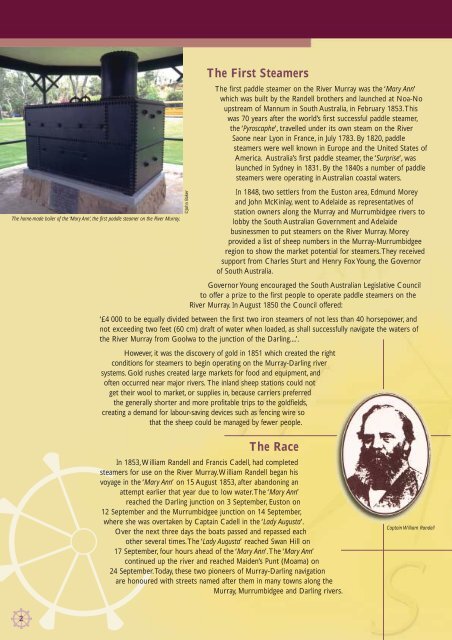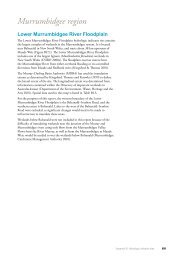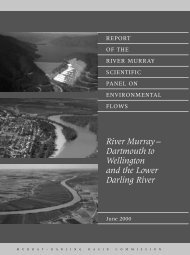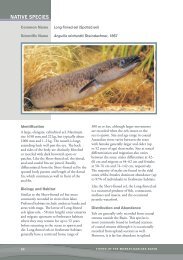Inland shipping navigation murraydarling river system
Inland shipping navigation murraydarling river system
Inland shipping navigation murraydarling river system
You also want an ePaper? Increase the reach of your titles
YUMPU automatically turns print PDFs into web optimized ePapers that Google loves.
The home-made boiler of the ‘Mary Ann’, the first paddle steamer on the River Murray.<br />
2<br />
©John Baker<br />
The First Steamers<br />
The first paddle steamer on the River Murray was the ‘Mary Ann’<br />
which was built by the Randell brothers and launched at Noa-No<br />
upstream of Mannum in South Australia, in February 1853.This<br />
was 70 years after the world’s first successful paddle steamer,<br />
the ‘Pyroscaphe’, travelled under its own steam on the River<br />
Saone near Lyon in France, in July 1783. By 1820, paddle<br />
steamers were well known in Europe and the United States of<br />
America. Australia’s first paddle steamer, the ‘Surprise’, was<br />
launched in Sydney in 1831. By the 1840s a number of paddle<br />
steamers were operating in Australian coastal waters.<br />
In 1848, two settlers from the Euston area, Edmund Morey<br />
and John McKinlay, went to Adelaide as representatives of<br />
station owners along the Murray and Murrumbidgee <strong>river</strong>s to<br />
lobby the South Australian Government and Adelaide<br />
businessmen to put steamers on the River Murray. Morey<br />
provided a list of sheep numbers in the Murray-Murrumbidgee<br />
region to show the market potential for steamers.They received<br />
support from Charles Sturt and Henry Fox Young, the Governor<br />
of South Australia.<br />
Governor Young encouraged the South Australian Legislative Council<br />
to offer a prize to the first people to operate paddle steamers on the<br />
River Murray. In August 1850 the Council offered:<br />
‘£4 000 to be equally divided between the first two iron steamers of not less than 40 horsepower, and<br />
not exceeding two feet (60 cm) draft of water when loaded, as shall successfully navigate the waters of<br />
the River Murray from Goolwa to the junction of the Darling....’.<br />
However, it was the discovery of gold in 1851 which created the right<br />
conditions for steamers to begin operating on the Murray-Darling <strong>river</strong><br />
<strong>system</strong>s. Gold rushes created large markets for food and equipment, and<br />
often occurred near major <strong>river</strong>s. The inland sheep stations could not<br />
get their wool to market, or supplies in, because carriers preferred<br />
the generally shorter and more profitable trips to the goldfields,<br />
creating a demand for labour-saving devices such as fencing wire so<br />
that the sheep could be managed by fewer people.<br />
The Race<br />
In 1853,William Randell and Francis Cadell, had completed<br />
steamers for use on the River Murray.William Randell began his<br />
voyage in the ‘Mary Ann’ on 15 August 1853, after abandoning an<br />
attempt earlier that year due to low water.The ‘Mary Ann’<br />
reached the Darling junction on 3 September, Euston on<br />
12 September and the Murrumbidgee junction on 14 September,<br />
where she was overtaken by Captain Cadell in the ‘Lady Augusta’.<br />
Over the next three days the boats passed and repassed each<br />
other several times.The ‘Lady Augusta’ reached Swan Hill on<br />
17 September, four hours ahead of the ‘Mary Ann’.The ‘Mary Ann’<br />
continued up the <strong>river</strong> and reached Maiden’s Punt (Moama) on<br />
24 September.Today, these two pioneers of Murray-Darling <strong>navigation</strong><br />
are honoured with streets named after them in many towns along the<br />
Murray, Murrumbidgee and Darling <strong>river</strong>s.<br />
Captain William Randell





